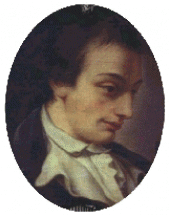Born in Massa in December 1728 into a family having a rich musical heritage, PIETRO ALESSANDRO GUGLIELMI received his earliest education from his father and his uncle who started him in counterpoint, viola and keyboard. Later, thanks to the protection offered by the Duchess Ricciarda Gonzaga of Massa, he was admitted to the S. Maria of Loreto Conservatory of Naples into Francesco Durantes’s class which he probably attended until 1754. It was still in Naples where he made his debut in the comic opera genre (“Lo solachianello imbroglione”, 1757), but his first serious opera, “Tito Manlio” was staged in Rome in 1763. After years of intense activity in Florence, Padua, Turin and Venice in 1767 he moved to England where he was appointed composer for and musical director of the King’s Theatre where he stayed until 1772, notwithstanding the open hostilities of his colleagues due in large part to the success he obtained for his numerous works. His return to Italy was marked by other moves, not least those involving the cities of Naples and Rome, the latter giving him the possibility of taking over Antonio Borroni’s place as kappelmeister of S. Peter’s under Pio Vl’s papal rule, and, in 1797 the same position at S. Lorenzo in Lucina. As a writer of opera Guglielmi enjoyed great fame during his life, to such a point that he was considered on a par with his contemporaries Cimarosa and Paisello, concrete proof of his acclaim notable in the commissions he received from the Neapolitan court for official occasions. Even if he did not disdain the normal composing practice of outlining the principal lines leaving his pupils to complete the work, a common enough modus operandi in that period, Pietro appears as a whole, as a composer of international tastes and in no wise a conservative. The serious operas reveal a greater number of ensemble pieces, especially duets and trios, which in the period following the 1760's mostly exploit the “explicit” in the first and second acts, focal points of the drama thanks to the use of a unifying construction that conducts the listener to the apogee. The employment of a varied “da capo” form contributes to this effect. The later compositions from the 90’s on tend to be given over to two-act works having a simplified structure and experiment with a greater ease of passage between the recitatives and arias. Similar developments can be traced also in the comic repertoire after 1770 where the climax of the plot is reached in the last scenes of an act where an ever-increasing number of participants tends to compress the action. The “da capo” aria is gradually replaced with other more varied and flexible models adapted to the exigencies of the texts. His sacred music, largely unknown, is marked by the innate ability of the counterpoint writing and for his tendency to use structures for effect in the same manner as his operas, above all in the final sections. They are mature works dating from the later years of his career when he was employed as the kappelmeister at Rome. In the catalogue of his chamber music works his pieces for harpsichord are to be recommended. Structured generally in two movements (a fast tempo movement followed by a minuet or a rondo) they retain their interest notwithstanding their repetitiveness by the way the composer plays with the sound and mechanical possibilities that the instrument offers, sometimes including dynamic solutions that will be further developed at a later date by composers for the pianoforte. CATALOGUE OF WORKS [Reference is made to the organisation of the works as is presented in “The New Grove Dictionary of Music and Musicians”, vol. Vll, London, 1980, and in the “Dizionario della musica e dei musicisti”, 2Le Biografie”, vol. III, Torino, 1980]. VOCAL MUSIC [Places and dates refer to the first performance; we cite only those comic operas which were performed for thirty years or more] OPERAS 32 serious operas · Tito Manlio (G. Roccaforte), Roma, Teatro Argentina, 1763; · L’Olimpiade (P. Metastasio), Napoli, Teatro S. Carlo, 1763; · Siroe re di Persia (P. Metastasio), Firenze, Teatro La Pergola, 1764; · Farnace (A. M. Lucchini), Roma, Teatro Argentina, 1765; · Tamerlano (A. Piovene), Venezia, Teatro S. Salvatore, 1765; · Adriano in Siria (P. Metastasio), Venezia, Teatro S. Benedetto, 1765; · Sesostri (A. Zeno, P. Pariati), Venezia, Teatro S. Salvatore, 1766; · Demofoonte (P. Metastasio), Treviso, Teatro Onigo, 1766; · Antigono (P. Metastasio), Milano, Teatro Ducale, 1767; · Il re pastore (P. Metastasio), Venezia, Teatro S. Benedetto, 1767; · Ifigenia in Aulide (G. Bottarelli), Londra, King’s Theatre, 1768; · Alceste (Calzabigi), Milano, Teatro Ducale, 1768; · Ruggiero (C. Mazzolà), Venezia, Teatro S. Salvatore, 1769; · Ezio (P. Metastasio), Londra, King’s Theatre, 1770; · Demetrio (G. Bottarelli da Metastasio), Londra, King’s Theatre, 1772; · Tamas Kouli-Kan nelle Indie (V. A. Cigna-Santi), Firenze, Teatro La Pergola, 1774; · Merope (A. Zeno), Torino, Teatro Regio, 1775; · Vologeso (da Lucio Vero di A. Zeno), Milano, Teatro Ducale, 1775; · Semiramide riconosciuta (P. Metastasio), Napoli, Teatro S. Carlo, 1776; · Artaserse (P. Metastasio), Roma, Teatro Argentina, 1777; · Ricimero (da F. Silvani), Napoli, Teatro S. Carlo, 1777; · Enea e Lavinia (V. De Stefano o G. Sertor), Napoli, Teatro S. Carlo, 1785; · Laconte (G. Pagliuca), Napoli, Teatro S. Carlo, 1787; · Arsace (G. de Gamerra, da Medonte), Venezia, Teatro S. Benedetto, 1788; · Rinaldo (G. Foppa), Venezia, Teatro S. Benedetto, 1789; · Ademira (F. Moretti), Napoli, Teatro S. Carlo, 1789; · Alessandro nell’Indie (P. Metastasio), Napoli, Teatro S. Carlo, 1789; · Il trionfo di Camilla (S. Stampiglia), Napoli, Teatro S. Carlo, 1795; · La morte di Cleopatra (A.S. Sografi), Napoli, Teatro S. Carlo, 1796; · Ippolito, Napoli, Teatro S. Carlo, 1798; · Siface e Sofonisba (A. L. Tottola), Napoli, Teatro S. Carlo, 1802. 47 comic operas of which: · Lo solachianello imbroglione (D. Pignataro), Napoli, Teatro dei Fiorentini, 1757; · Il ratto della sposa (Martinelli), Venezia, Teatro di S. Moisè, 1765; · La sposa fedele (P. Chiari), Venezia, Teatro di S. Moisè, 1767; · L’impresa d’opera (B. Cavalieri), Venezia, Teatro di S. Moisè, 1769; · La villanella ingentilita (S. Zini), Napoli, Teatro dei Fiorentini, 1779; · La Quakera spiritosa (Palomba), Napoli, Teatro dei Fiorentini, 1783; · Le vicende d’amore (G. B. Neri), Roma, 1784; · La virtuosa di Mergellina ( S. Zini), Napoli, Teatro Nuovo, 1785; · La pastorella nobile ( S. Zini), Napoli, Teatro del Fondo, 1788; · La bella pescatrice ( S. Zini), Napoli, Teatro Nuovo, 1789; · La serva innamorata (Palomba), Napoli, Teatro del Fondo, 1790. II-SINGLE ACTS AND THEATRICAL EVENTS · Componimento drammatico per le faustissime nozze di S. E. il cavaliere Luigi Mocenigo colla N. D. Francesca Grimani (A. Borga), Venezia, Palazzo Mocenigo, 1766; · La felicità dell’Anfrisio (componimento drammatico, Pagliuca), Napoli, Teatro S. Carlo, 1783. III-INTERMEZZOS · La ricca locandiera (A. Palomba), Roma, Teatro Capranica, 1759; · I Cacciatori (da C. Goldoni), Roma, Teatro Tordinona, 1762; · La contadina superba ovvero il giocator burlato, Roma, 1744; · Gli intrighi di don Facilone, Roma, 1775; · Narcisso (A. Palomba), Napoli, Accademia di Dame e Cavalieri, 1779. IV-ORATORIOS · La madre de’ Maccabei (G. Barbieri), Roma, Congregazione dell’Oratorio, 1764; · Debora e Sisara (C. Sernicola), Napoli, Teatro S. Carlo, 1788; · La Passione di Gesù Cristo, Madrid, 1790; · La morte di Oloferne (dalla Betulia liberata di Metastasio), Napoli, 1791; · Gionata Maccabeo, Napoli, Teatro S. Carlo, 1798; · Il sacrificio di Jefte, Napoli, 1801; · Il Paradiso perduto cioè Adamo ed Eva per il loro noto peccato discacciati dal Paradiso terrestre (azione sacra, Rasi), Roma, Oratorio di S. Maria in Vallicella, 1802. V-CANTATAS AND SERENADES · Telemaco (cantata, Petrosellini), Roma, Palazzo Bracciano, 1775; · Cantata per il genetliaco della Sovrana (G. Jacopetti), Massa, 1776; · Diana amante (serenata, L. Serio dall’Endimione di Metastasio), Napoli, Accademia di Dame e Cavalieri, 1781; · Pallade (cantata, C. G. Lanfranchi Rossi), Napoli, Teatro S. Carlo, 1786; · Il serraglio (cantata, A. L. Palli), 1790. VI-MASSES · 7 Missae breves [1 a 4 vv. e strum.; 1 a 4 vv. e orch.; 2 a 4 vv. e org.; 1 a 5 vv. e strum.; 2 a 8 vv. e strum.]. VII- OTHER SACRED COMPOSITIONS · Requiem [4 vv. e orch.]; · 10 Credo [3, 4, 5, 8 vv. e strum. o b.c.]; · 2 Offertori [v. e org.]; · 2 Magnificat [1 a 4 vv. e orch.; 1 a 8 vv., archi e org.]; · 3 Miserere [3, 4, 5 vv. e org.]; · Musica per l’agonia di Nostro Signore Gesù Cristo [3 vv. a cappella]; · Numerosi salmi e mottetti. INSTRUMENTAL MUSIC [Dates and places where the works were published are indicated in brackets] I-SYMPHONIES · 15 Sinfonie, Ms. II-CONCERTOS · 1 Concerto per vl. (perduto); · 1 Concerto per clav. (perduto). III-QUARTETS · 6 Quartetti op. 1 [2vl., vcl., clav.], Londra, 1768; · A Conversation Quartetto [fl. o ob., vl., vla e vcl], Londra; · 6 Quartetti a 2 clav., Ms. IV-SOLO MUSIC · 6 Sonate op. 3 [clav.], Londra, 1772; · The Favorite Scotch Divertissement [clav.], Londra, ca. 1795; · 4 Sonate per clav., Ms; · 2 Toccate e 2 Capricci per pf., Ms. V-OTHER INSTRUMENTAL COMPOSITIONS · 6 Divertimenti op. 2 [clav., vl.], Londra, ca. 1770; · 3 Divertimenti [clav. e vl.], Ms; · 6 Divertimenti a 4 per archi, Ms, 1768. BIBLIOGRAPHY · G. Bustico, Un musicista poco noto nel Settecento: Pietro Alessandro Guglielmi, in «Rivista Teatrale Italiana», I (1901), p. 246; · F. Piovano, Elenco cronologico delle opere (1757-1802) di Pietro Guglielmi (1727-1804), in «Rivista Musicale Italiana», XII (1905), pp. 407-447; · G. Bustico, Pietro Metastasio e Pier Alessandro Guglielmi, in «Rivista Teatrale Italiana», VII (1908), p. 257; · A. Della Corte, L’opera comica italiana nel ‘700, Bari, 1923; · G. Bustico, Un musicista massese: Pier Alessandro Guglielmi, Barga, 1923; · S. Giampaoli, Musica e Teatro alla corte di Massa. I Guglielmi, Massa, 1978; · J. L. Jackman, Pietro Alessandro Guglielmi, in The New Grove Dictionary of music and musicians, vol. VII, Londra, 1980, pp. 793-798; · G. Magri, Pietro Alessandro Guglielmi, Massa, 1984; · R. Bossa, Pietro Alessandro Guglielmi, Dizionario della musica e dei musicisti, vol. III (Le Biografie), Torino, 1985, pp. 357-359
Vocal Music
"Debora e Sisara"
Duetto "Caro medico garbato"
Duetto "Pe spassarme, io poverella"
Chamber music
4 String Quartets "Butler"










